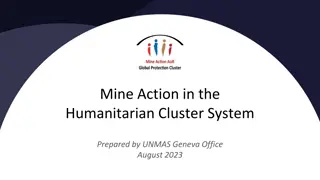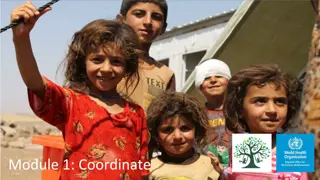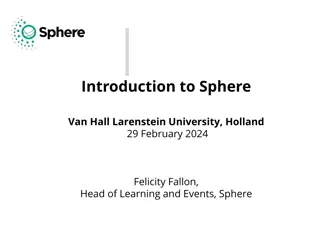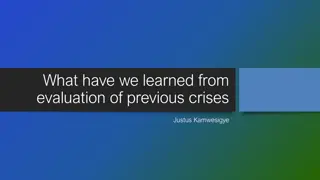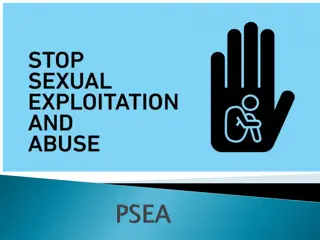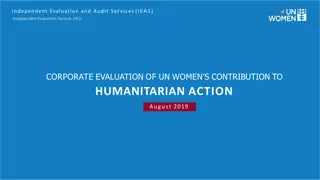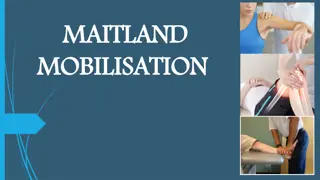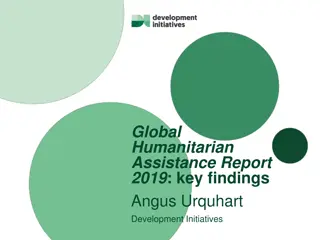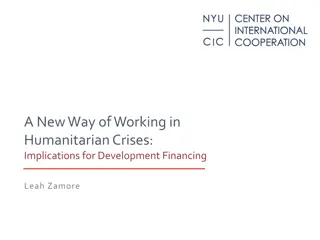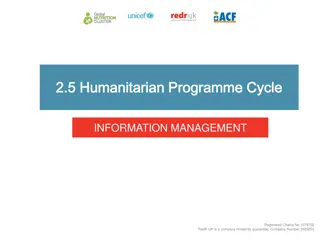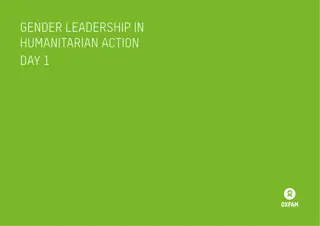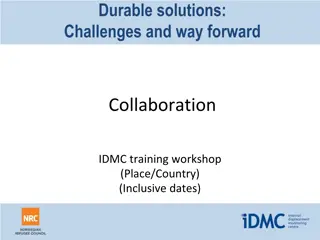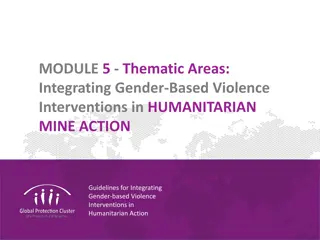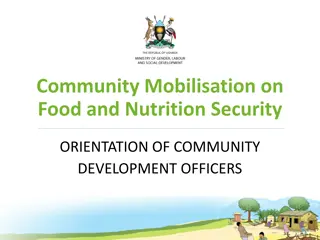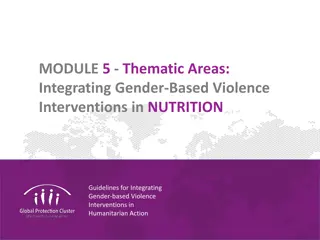Humanitarian Resource Mobilisation and Information Management Tools
The content discusses the role of Information Management Officers (IMOs) and Cluster Coordinators in resource mobilization within humanitarian settings. It emphasizes the importance of tools such as financial tracking systems, capacity mapping, and checklists in informing the resource mobilization stage. Furthermore, it highlights the significance of financing strategic objectives and cluster plans through various sources like Central Emergency Response Fund (CERF). The role of IMOs in consolidating funding inputs and presenting funding gaps to cluster partners is also outlined.
Download Presentation

Please find below an Image/Link to download the presentation.
The content on the website is provided AS IS for your information and personal use only. It may not be sold, licensed, or shared on other websites without obtaining consent from the author.If you encounter any issues during the download, it is possible that the publisher has removed the file from their server.
You are allowed to download the files provided on this website for personal or commercial use, subject to the condition that they are used lawfully. All files are the property of their respective owners.
The content on the website is provided AS IS for your information and personal use only. It may not be sold, licensed, or shared on other websites without obtaining consent from the author.
E N D
Presentation Transcript
3.4 3.4 Resource Mobilisation & IM Tools: Resource Mobilisation & IM Tools: Part 1: Finance Part 1: Finance INFORMATION MANAGEMENT Registered Charity No 1079752 RedR UK is a company limited by guarantee. Company Number 3929653
IMO Role in Resource Mobilisation stage of the HPC IMO responsibilities include support to the NCC in resource mobilisation by ensuring availability of the up-to-date information on: Financial Resources Human Resources Supplies
Role of the Cluster Coordinator Have an overview of funding requirements and available funds with inputs from partners through Financial Tracking System (FTS) Establishes the funding gaps and advocates on behalf of the cluster And the role of IMO?
Role of the IMO Consolidates inputs from the partners on funding received through Cluster financial tracking tool Establishes the funding gaps and presents to the CC and the cluster partners
What GNC IM Tools inform the Resource Mobilisation stage? Financial tracking tool HRP tips Caseload targets & supplies Capacity mapping IM Checklist
Humanitarian Financing Financing of strategic objectives and cluster plans through Agency, issue and situation specific resource mobilization, particularly for women and girls e.g. nutrition spending by groups (women, men, boys and girls etc.). Central Emergency Response Fund (CERF) Country-based Pooled Funds Private sector / civil society National governments bilateral donations multilateral donations NOTE: Financing is per SO (budget per SO!)
Central Emergency Response Fund (CERF) (approx.10% of funding) Rapid Response Grant and Grant for Underfunded Emergencies; Disbursed by OCHA only to UN agencies and IOM; Grant to jump start critical operations and fund life-saving operations based on Strategic Statement / HRP objectives, considering gender and protection criteria; Cluster in consultation with partners identify priority areas for funding, including funds for cluster coordination; Cluster Coordinator ensures the inclusion of nutrition cluster interventions in the CERF application submitted by CLA on behalf of UN partners; NGOs can receive funds as implementing partners of UN agencies.
Country-based Pooled Funds (approximately 20% of funding) Country-based pooled funds (CBPFs) are multi-donor humanitarian financing instruments established by the Emergency Relief Coordinator (ERC). Replacing all other country-level funds including ERF and CHF. Managed by OCHA at country-level under the leadership of the HC. Donor contributions to each CBPF are un-earmarked and allocated by the HC through an in-country consultative process. Allocated based on identified humanitarian needs and priorities at country level Allocations go to all partners of the response. Four principles underpin the use of CBPFs: Inclusiveness. Flexibility Timeliness Efficiency
What GNC IM Tools inform the Resource Mobilisation stage? Financial tracking HRP tips Caseload targets & supplies Capacity mapping IM Checklist
Financial tracking tool INFORMATION MANAGEMENT Registered Charity No 1079752 RedR UK is a company limited by guarantee. Company Number 3929653
Financial tracking tool The Financial Tracking tool assists the NCC to identify and communicate high priority funding gaps quickly and efficiently to enhance humanitarian response. Helps to avoid common challenges such as corruptions, double-counting of funding received. Identifies: Funding requirements Funding received / committed from different sources Funding gaps for both UN agencies and implementing partners. It is typically completed by partners on a regular basis. IMO consolidates and validates the data and ensure that double-counting is avoided.
Exercise: Financial tracking tool In your groups review the Financial tracking tool on your computers (approx 10 minutes). Create a flip chart answering the following questions in your group (approx 15 minutes): What challenges do you face with regards to financial tracking in your location? How would you collect this information? How you collect the information on corruption among the partners and implementers? How you calculate the loss of money and resources because of corruption? What would be the benefits and constraints of using the Financial tracking tool? How you will track and monitor the corruptions using the Information Management Tools?



